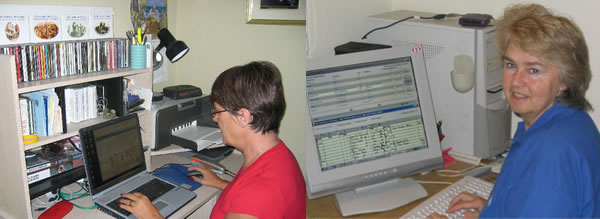
|
Ann and Carole, volunteers on the
UKIndexer project.
A help wizard explains all the common problems new users have when subscribing or using the site. Another bonus is that the session time has now been increased, so you are unlikely to be logged out while checking your notes or adding information from the site to your research.
All-inclusive subscriptions From the point of view of most users, the biggest improvement is the introduction of allinclusive subscriptions. Previously you subscribed to databases individually, and you still can if you wish, but from
£4.66 a month (based on an annual subscription) you can access almost all the data which would currently cost around
£2,000 a year as individual subscriptions. If you wish, you can spread your payment across the year with some subscription options. The new data, appearing weekly, is immediately available to all-inclusive subscribers at no additional charge. |
This pro-active approach to getting the indexing right, using many stages of checking by both people and software, should ensure that the transcripts are to the highest standard possible. Nevertheless the online service at www.thegenealogist.co.uk has a reporting system for users to report errors that they find due to their particular knowledge of a family or location.
Images
As more transcripts are completed and made available online, the S&N staff are linking images to them, starting with London, Yorkshire and Lancashire (the three largest areas), although some smaller counties do already have images. There are complete surname indexes and/or transcripts available for many counties and the list grows by the week so it is best to check the website for availability.
Census indexes
Much of the data online at present complements the
|
British Data Archive’s census CDs and is in the form of surname indexes or census transcripts. The search results of both surname indexes and transcripts can be used to find the original page image on microfilm or on their CD sets. This can also be useful if you haven’t broadband access, as image downloads can be slow.
BMD indexes
The BMDindex at www.bmdindex.co.uk is a complete index to the birth, marriage and death registrations from 1837 to 2003. It is in the form of page images of the General Register Office (GRO) index and are indexed by the range of names they contain, thus a search for a name in a single year will bring up four pages to check, one for each quarter, even if the name doesn’t appear on any of them. From 1984 the records are fully digitised and searchable, and include tools that enable you to find spouses and children.
|
Other records
During the first part of 2006, S&N staff will be putting a great deal of their CD material online. The parish record section contains a lot of the Phillimore’s parish record marriage transcripts, plus there is the 1873 Returns of Owners of Land for England and Wales and some trade directories, for London only at present. There is also the Crew List Index Project (one of the only databases not available within the all-inclusive subscriptions), which lists the crews of vessels sailing between 1863 and 1913.
Searches
There have been recent improvements to the search engine, which will now accept wild cards with a group of three letters in any part of a name. You can also look for variants of surnames and for nicknames. The advanced search form for the census transcripts now includes all the fields in the results: forename, surname, age, occupation, relationship and county of birth.
|